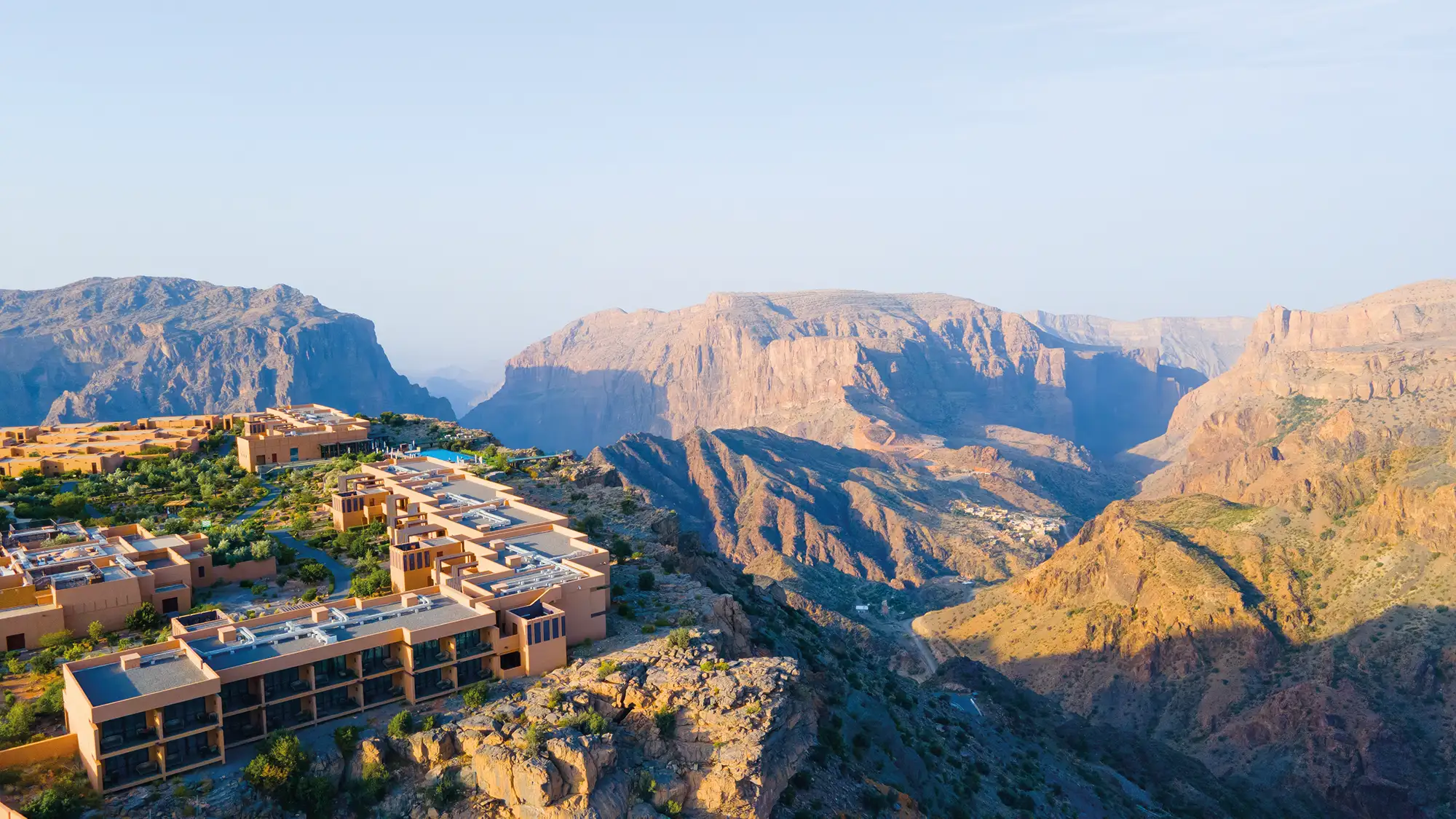Hiking the green mountains
The canyons, terraces and villages of Jabal Akhdar reveal another Oman.
By Nicola Chilton
Walking along the edge of a falaj is a precarious business. Hassan Al Daghari, who is guiding me on a trek to three remote settlements on Oman’s Saiq Plateau, has been doing it for years. As I wobble on the raised edge of the water channel, gingerly putting one foot in front of the other and trying not to look down at the boys splashing in the spring below, he tells me that balance is “all in the mind.”
The springs that fill these falaj channels gave this part of the Hajar Mountains its name. The farms of Jabal Akhdar, meaning green mountain, have been fed by these waters for centuries. At first, it feels like a misnomer. As I drive up the steep, twisty road from Birkat Al Mouz in the foothills, my ears popping, the landscape looks arid and inhospitable. Some of the rocky mountainsides are a millefeuille of diagonal layers, like a stack of pancakes sliding off a plate. Others have swirling patterns that remind me of Venetian marbled paper. But the higher we climb, the greener it becomes.
My base for the next few days is the Anantara Al Jabal Al Akhdar, a resort perched 2,000 metres up on a cliff edge where endangered Egyptian vultures ride thermals that rise from the valley below. The property sits above a deep gorge, lined with terraced farms carved out of the vertiginous slopes by farmers over centuries. The three villages we’re walking to—Al Aqr, Al Ayn, and Ash Shirayjah—have also been here for centuries, built in this unlikely place because of its proximity to the water sources that fed, and still feed, the farms. Most villagers left when new houses with modern conveniences arrived at the top of the plateau, freeing them of the need to trek along rocky trails to get home.
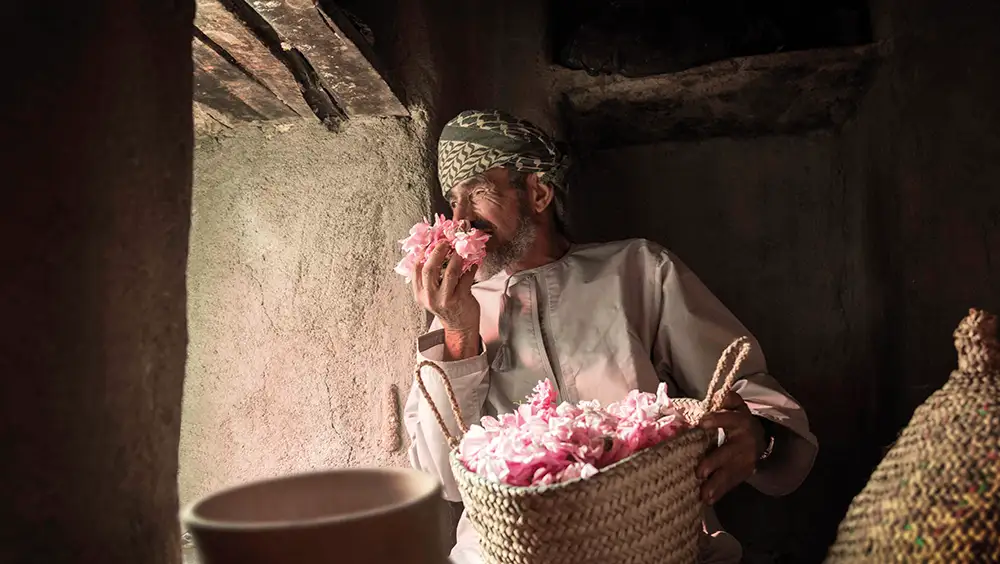
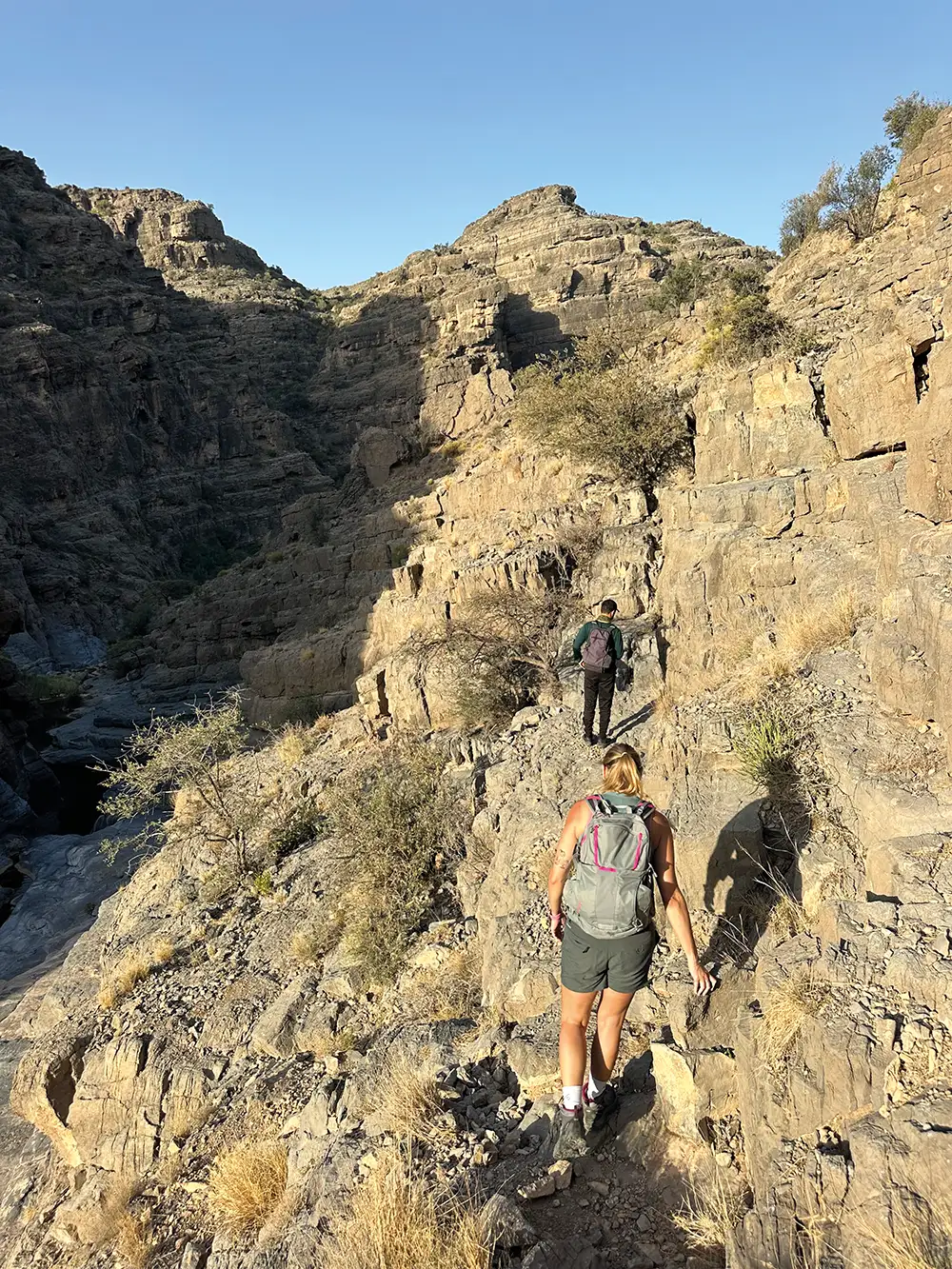
Opening image, the Anantara Al Jabal Al Akhdar Resort is perched 2,000 metres up on the edge of a deep gorge, where endangered Egyptian vultures ride thermals that rise from the valley below. Top, rosewater has been produced in Jabal Akhdar for centuries. From March to May, Damask roses bloom on the mountain terraces, painting them a powdery pink. Above, Hussein Al Zakwani, a guide and Jabal Akhdar native, leads the challenging hike to Wadi Al Masdara. Hero image and Rosewater courtesy of Anantara Al Jabal Al Akhdar Resort; Above, Nicola Chilton.
As we approach the first village, people are tending their fields in the distance, carrying enormous bundles of cut grass wrapped in colourful fabrics on their heads. Al Daghari says that nothing is easy here, and as we walk down a steep slope it’s easy to see why the villagers chose to relocate to flatter ground. The quiet of the mountains is broken by the clink of hammers on rock as a team of builders restores a stone house. While Al Aqr may no longer have a permanent population, former residents are working to bring life—and visitors—back to the village.
We step inside the Bayt Alsharaf Museum, opened in 2022 by Youssef Al Ameri, who was born and raised in Al Aqr. Like many of his neighbours, he left in the 1990s but has returned to renovate and reopen his house as a showcase of what life was like. Thick stone walls regulate temperatures within, and I bend low to squeeze into the windowless Winter Room, a tiny space designed for cosiness in cold weather, and into the Room of the Sheep, where animals were kept overnight before being released to graze in the morning. Other rooms contain an old radio, cooking utensils, and water containers made from animal skins.
We follow a smoky smell to the house’s rosewater distillery, and Al Daghari shows me how roses are processed in the traditional way using woodfire and steam, a technique he learnt from his father. Rosewater has been produced in Jabal Akhdar for centuries. In April, the terraced fields here blush a powdery pink, and the air is filled with the fragrance of damask roses.
A few doors away, the Hanging Terraces guesthouse occupies three more restored stone houses. Between them is the café, cooled by mountain breezes that enter through windows with dramatic views of the chasm below. There are roses here too, their petals dried and placed beneath glass tabletops where walkers sit to refuel with coffee and coconut cake.
I’m too late for the roses when I visit in June, but as we continue our walk to the second village, Al Ayn, we pass trees laden with shiny pomegranates, bunches of green grapes that will soon ripen in the summer sun, and peaches, figs, and walnuts. I’m surprised to see big, bushy olive trees, their boughs already full of the fruit that will be harvested and pressed into oil in the autumn. Olives are not native to these mountains but have been introduced. Today they’re thriving, with close to 20,000 trees growing around Jabal Akhdar.
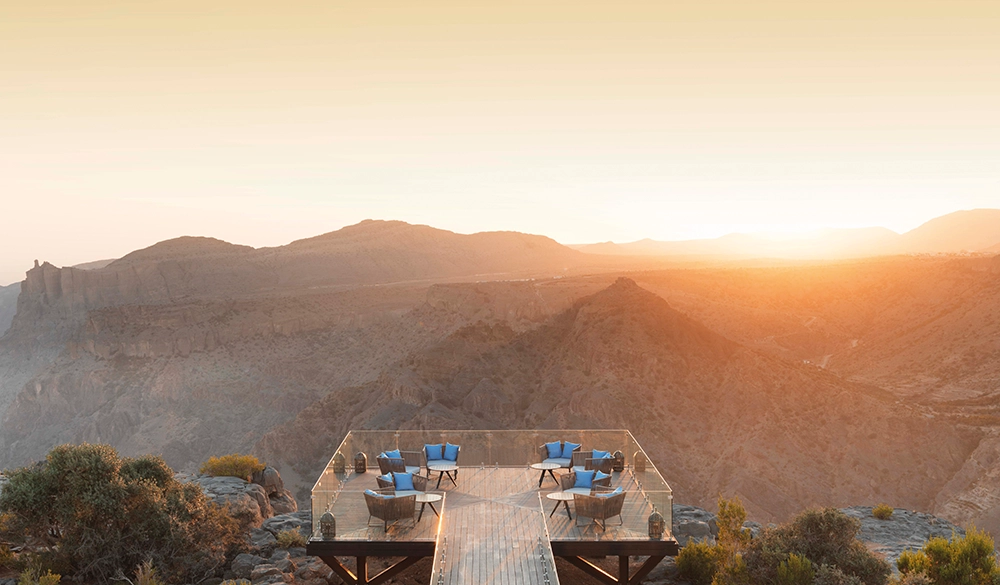
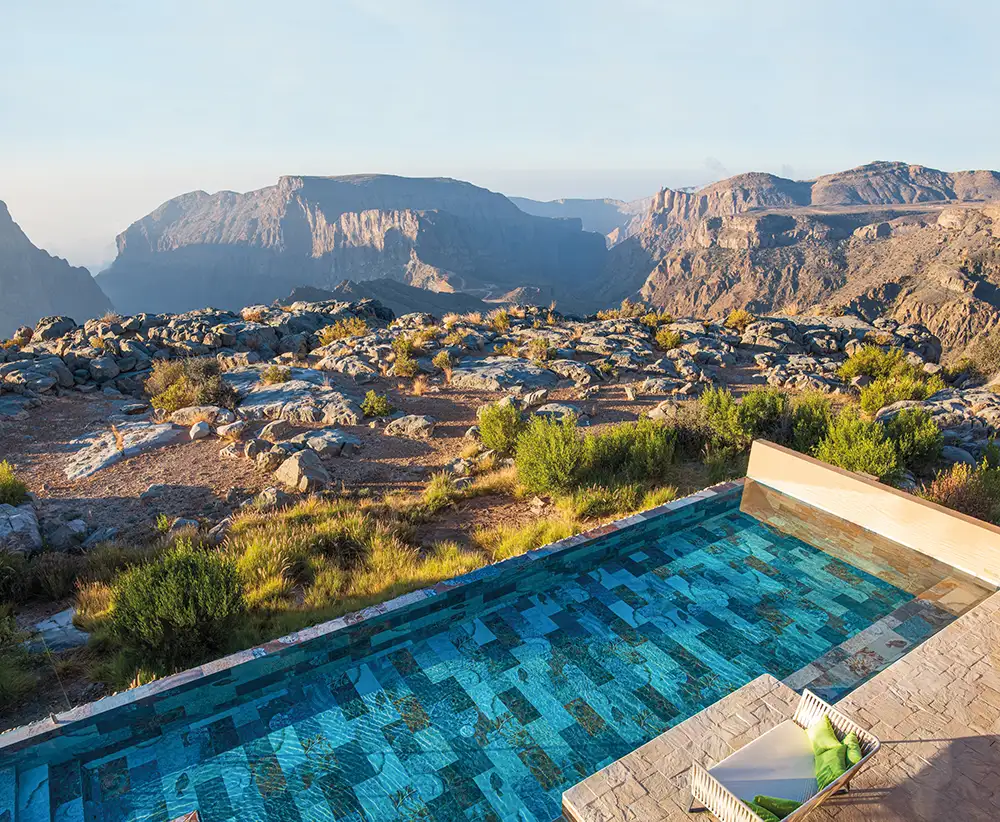
Top, two hours’ drive inland from Muscat, Jabal Akhdar offers cooler mountain air, dramatic canyon views, and stargazing from the platform where Princess Diana once stood. Above, the swimming pool at the Anantara Al Jabal Al Akhdar Resort offers expansive views, and relaxation after a day spent hiking. Top image by Paul Thuysbaert, both courtesy of the Anantara Al Jabal Al Akhdar Resort.
Al Daghari stops and asks me to look closely as he pours water on rocks that line the trail, revealing detailed marine fossils. We’re walking on what used to be the seabed, thrust up two kilometres by the force of the Arabian and Eurasian tectonic plates colliding 80 million years ago. As we approach Al Ayn, the village almost appears to float, a patch of brilliant green fields seemingly suspended above the grey gorge. At its centre is the tiny blue dome of a mosque, surrounded by rosebushes and date palms. It’s here that we balance on the falaj, water running clear and cold beneath our feet. We walk past fields divided into neat, square parcels recently planted with corn. As we pass through the village, we help ourselves to the sticky black dates that one villager has left outside his house for passing visitors, giving us a final burst of energy to descend through the terraces to Ash Shirayjah.
The following day we take things up a level, graduating from a leisurely village walk to the more challenging hike to Wadi Al Masdara. I wake at 4am, pull on my hiking gear, and head out to meet another of Anantara’s guides, Hussein Al Zakwani. He takes me to a lookout spot for coffee, dates, and a sunrise view, a gentle start before we begin our tough descent into the gorge. Heat in the lowlands creates a thick layer of haze below us, and as the sky becomes lighter, the mountains are silhouetted in layers of grey, like a Chinese ink wash painting. By 5am it’s daylight, and we start our hike before the sun gets any higher.
Like Al Daghari, Al Zakwani is a Jabal Akhdar native. These mountains and canyons are in his blood. In addition to guiding hikes, he’s also a rock-climbing instructor. As our boots crunch on jagged rocks, he bends down to pick some sprigs from a silvery plant and rubs it between his fingers. It’s mountain lavender, he says, good for the stomach if it’s turned into tea.
The trail down to the wadi is steep, more of a scramble than a hike, requiring the use of hands for stability as my legs stretch to find toe-holds. By 6:30am we’re at the bottom of the canyon where the wadi flows. The water is brown due to heavy rains a few days earlier, but my sense of achievement means it’s still beautiful.
The scramble back up is easier, gravity seeming to pull us skywards rather than threatening to throw us deep into the canyon. We make it to the top quickly. Back at the hotel, I take my weary body to breakfast where I’m presented with figs fresh from the garden, sweet, juicy and still warm from the morning sun. It feels like the green mountain is giving life not only to the figs, grapes and olives that thrive here, but also to a new energy in its old settlements. There’s a soul and a beauty to these remote places that are all their own, worth even the hardest of hikes to get to.

